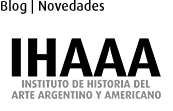The Body of the World in Three Hundred Boxes
Bernardo Croce’s Stereoscopic Trips (1910-1940)
DOI:
https://doi.org/10.24215/23142502e018Keywords:
Bernardo Croce, Argentina, amateurism, stereoscopy, PhotographyAbstract
A few years ago, a collection of five thousand stereoscopic glass plates from the early 20th century was found in Buenos Aires. It belonged to late Bernardo Croce, an Argentine doctor and amateur photographer. The images, produced within the framework of family life, bourgeois leisure and world travel, are historically inscribed in the beginnings of the massification of photography and, at the same time, in the specificity of the stereoscopic system as a late vulgarization of the epistemological reformulation of the status of vision in the 19th century. This article proposes to reflect, on the phenomenon of stereoscopy and its links with art, photomechanical representation and mass culture, as well as some methodological problems raised by this type of object in relation to its patrimonialization.Downloads
References
Benjamin, W. [1936] (1989). La obra de arte en la época de su reproductibilidad técnica. En Discursos interrumpidos I (pp. 15-57). Ciudad Autónoma de Buenos Aires, Argentina: Taurus.
Bibliografía. (julio de 1894). Revista Fotográfica Ilustrada del Río de la Plata, 1(11), 176. Boure [sic por Bourée], H. (1929). Consejos a los estereoscopistas. Foto-Magazine, 3(32), 300-301.
Chéroux, C. (2013). Breve historia del error fotográfico. Ciudad de México, México: Vestalia Ediciones.
Crary, J. (2008). Las técnicas del observador. Visión y modernidad en el siglo xix. Murcia, España: Cendeac.
Darrah, W. C. (1997). The World of Stereographs [El mundo de las estereografías]. Michigan, Estados Unidos: Land Yacht Press.
Donnadieu, A. L. (mayo de 1894). Observaciones sobre la separación en fotoestereoscopía. Revista Fotográfica Ilustrada del Río de la Plata, 1(9), 141-143.
Estereoscopía. Los anáglifos por virajes. (20 de febrero de 1930). Foto-Magazine, 3(36), 420-422.
Facio, S. (1995). La fotografía en la Argentina. Desde 1840 a nuestros días. Ciudad Autónoma de Buenos Aires, Argentina: La Azotea.
Frizot, M. (2009). El imaginario fotográfico. Ciudad de México, México: Vestalia Ediciones.
Irvin, S. (2005). Appropriation and Authorship in Contemporary Art [Apropiación y autoría en el arte contemporáneo]. British Journal of Aesthetics, 45(2), 123-137. https://doi.org/10.1093/aesthj/ayi015
Phillips, C. (1997). El tribunal de la fotografía. En G. Picazo y J. Ribalta (Comps.), Indiferencia y singularidad. La fotografía en el pensamiento artístico contemporáneo (pp. 59-98). Barcelona, España: MACBA.
Prensa estereoscópica. (julio de 1894). Revista Fotográfica Ilustrada del Río de la Plata, 1(11), 173.
Revista de periódicos. (enero de 1894). Revista Fotográfica Ilustrada del Río de la Plata, 1(5), 79-80.
Sontag, S. (2006). Sobre la fotografía. Ciudad de México, México: Alfaguara.
Tagg, J. (2005). El peso de la representación. Ensayos sobre fotografías e historias. Barcelona, España: Gustavo Gili.
Tell, V. (2017). El lado visible. Fotografía y progreso en la Argentina a fines del siglo xix. San Martín, Argentina: UNSAM.
Downloads
Published
How to Cite
Issue
Section
License
According to these terms, the material can be copied and redistributed by any means or in any format as long as a) the author and original source of the publication are quoted (magazine and URL of the work), access to the license is provided and whether changes have been made is mentioned; and b) the material is not used for commercial purposes.
The cession of non-exclusive rights means that after the publication (post print) in Boletín de Arte the authors can publish their work in any language, means and format; in such cases it must be mentioned that the material was originally published in this magazine.
Such cession also means the authorization of the authors for the work to be collected by SEDICI, the institutional archive of the National University of La Plata, and to be spread in the databases that the editorial team considers appropriate to increase the visibility of the publication and its authors.
Moreover, the magazine encourages the authors to deposit their productions in other institutional and thematic archives under the principle that offering the society the scientific and academic production without any restrictions contributes to a greater exchange of the global knowledge.
































